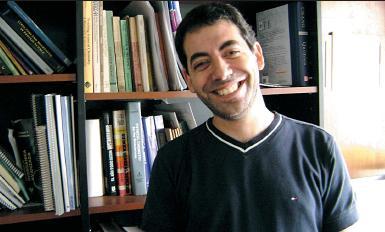|
|
Biography |
|
|
 Adrián Turjanski obtained his Master degree in Chemistry from the University of Buenos Aires
in Argentina in 1999, and then his PhD in Biophysics in 2003. He conducted postdoctoral
studies in the area of molecular modeling from 2003 to 2005 in the Department of Physiology
and Molecular Biology, School of Sciences, University of Buenos Aires. He then conducted
postdoctoral work in Bioinformatics as a 2005 Pew Latin American Fellow in the National
Institute of Dental and Craniofacial Research at the National Institutes of Health. Bethesda,
MD,USA. In 2008 he returned to Argentina where he is in charge of the Structural Bioinformatics
Lab, in the school of sciences at the University of Buenos Aires. He is part of the research staff
of the National Research and Technology Council (CONICET) as Adjunct Investigator. He has
also been a Professor of Bioinformatics at the University of Buenos Aires since 2008. In 2013
he became director of the Argentinian Bioinformatic Platform. His research is focused in the
developing and application of Bioinformatics tools for drug discovery.
Adrián Turjanski obtained his Master degree in Chemistry from the University of Buenos Aires
in Argentina in 1999, and then his PhD in Biophysics in 2003. He conducted postdoctoral
studies in the area of molecular modeling from 2003 to 2005 in the Department of Physiology
and Molecular Biology, School of Sciences, University of Buenos Aires. He then conducted
postdoctoral work in Bioinformatics as a 2005 Pew Latin American Fellow in the National
Institute of Dental and Craniofacial Research at the National Institutes of Health. Bethesda,
MD,USA. In 2008 he returned to Argentina where he is in charge of the Structural Bioinformatics
Lab, in the school of sciences at the University of Buenos Aires. He is part of the research staff
of the National Research and Technology Council (CONICET) as Adjunct Investigator. He has
also been a Professor of Bioinformatics at the University of Buenos Aires since 2008. In 2013
he became director of the Argentinian Bioinformatic Platform. His research is focused in the
developing and application of Bioinformatics tools for drug discovery.
|
|
|
|
|
|
|
Abstract |
|
|
|
|
From Genomics to Drug Discovery in Tuberculosis |
|
|
|
|
|
In 2012, an estimated 8.6 million people developed TB and 1.3 million died from the disease (including 320 000 deaths among HIV-positive people). There is an urgent need for new anti-TB drugs due to the fact that current treatments have severe side effect, the emergence of multi and extensively-drug-resistant Mt strains, negative drug-drug interactions with certain HIV (or other disease) treatments and the ineffectiveness against dormant Mt. Taking this into account we use bioinformatics tools to help drug development in Mt.
Starting from the genome information of different Mt strains we compile relevant experimental information together with state of the art structural bioinformatics analysis in a consistent and effective manner, contributing to better selection of potential drug targets for screening campaigns and the analysis of targets for structure based rational drug design projects. Structural Druggability analysis is combined with features related to the characteristics of putative inhibitor binding pockets and with protein functional and biological context information. The structural analysis is performed on all available unique Mt structures and high quality structural homology based models and shown in an interactive manner, depicting the protein structure, the pockets and the associated characteristics for each protein. We also present previous gene essentiality information, as determined from whole cell based knock out experiments, and expression information obtained from microarray experiments done in different stress related conditions.
For specific selected candidates we performed high throughput docking simulations that allow to select specific drugs that are then tested in in-vitro experiments for inhibition of the selected proteins. Finally, the drugs are tested in Mt cultures to check effectiveness towards normal and resistant strains.
|
|
|
|
|